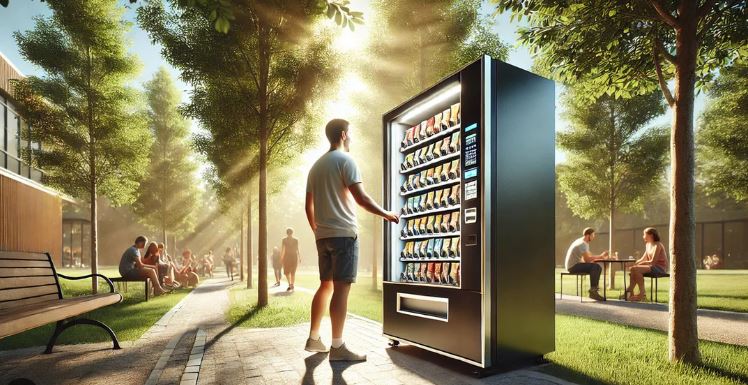Snack vending machines are a ubiquitous part of urban landscapes, offering a convenient way to grab a quick bite. But their functionality in extreme environments—sub-zero temperatures and scorching deserts—presents unique challenges. From polar research stations to arid outposts, vending machines are evolving to deliver snacks in the harshest climates. These specialized machines integrate groundbreaking technologies, blending durability, sustainability, and innovation to meet the demands of extreme environments.
The Challenges of Extreme Environments
Extreme conditions test the resilience of materials and machinery in ways most vending machines never experience. Consider a vending machine in Antarctica, where temperatures can plunge below -40°C, and winds whip at breakneck speeds. Or imagine one stationed in the Sahara Desert, enduring searing heat above 50°C, with sand particles threatening to jam its mechanisms. For such machines to function, they must overcome:
- Temperature Extremes: Conventional vending machines fail to operate when internal components freeze or overheat.
- Moisture and Humidity: Sub-zero temperatures can cause condensation and ice formation, while high heat leads to accelerated wear and tear on electronics.
- Dust and Sand: In deserts, fine particles infiltrate crevices, clogging gears and circuits.
- Energy Efficiency: Maintaining optimal conditions in remote or off-grid areas often requires innovative power solutions.
Engineering Solutions: Keeping Machines Running
Modern snack vending machines are undergoing a technological transformation to tackle these challenges. Advanced materials, insulation techniques, and energy-efficient systems are just a few ways manufacturers adapt these machines for extreme conditions.
Thermal Insulation and Climate Control
Temperature regulation is critical for vending machines in sub-zero or high-heat environments. Innovative features include:
- Vacuum-Insulated Panels (VIPs): These advanced panels minimize heat transfer, maintaining stable internal temperatures regardless of external extremes.
- Active Heating Systems: Electric heaters or heat pumps prevent freezing in sub-zero conditions, ensuring snacks remain accessible and electronics function properly.
- Cooling Systems: Deserts necessitate robust cooling solutions like thermoelectric coolers or phase-change materials, which absorb heat and maintain cool temperatures.
Sealed Designs and Dust Protection
For desert environments, vending machines incorporate hermetically sealed designs to keep dust and sand at bay. Key features include:
- Gasketed Doors: Rubber gaskets create tight seals, preventing particles from entering the machine.
- HEPA Filters: High-efficiency particulate air filters keep delicate electronics free from sand and dust.
- Anti-Corrosion Coatings: Protective coatings on metals resist rust caused by abrasive sand particles.
Energy Efficiency and Off-Grid Operation
Extreme environments often lack reliable power sources. To address this, vending machines now integrate:
- Solar Panels: Machines stationed in deserts use photovoltaic panels to generate electricity, powering refrigeration and dispensing mechanisms.
- Low-Energy Electronics: Microcontroller units (MCUs) manage energy consumption, ensuring power is used efficiently.
- Battery Backup Systems: Rechargeable batteries store surplus energy for use during power outages or extended periods of darkness.
Innovations Driving the Future
The evolution of vending machines for extreme environments is a fascinating intersection of engineering, sustainability, and technology. Emerging trends promise even greater adaptability and efficiency.
Smart Sensors for Environment Monitoring
IoT-enabled sensors are becoming standard in extreme-environment vending machines. These sensors:
- Monitor temperature, humidity, and dust levels in real time.
- Alert operators to potential issues like overheating, freezing, or mechanical malfunctions.
- Enable predictive maintenance, reducing downtime and repair costs.

AI-Powered Systems
Artificial intelligence is transforming vending machine operations:
- Dynamic Climate Control: AI systems adjust heating or cooling based on ambient conditions, optimizing energy use.
- Inventory Management: Machine-learning algorithms analyze purchasing patterns to ensure high-demand snacks are always stocked.
Sustainable Cooling Technologies
The refrigeration systems of the future are moving toward eco-friendly solutions, such as:
- Hydrocarbon Refrigerants: These natural refrigerants have low global warming potential (GWP) and high energy efficiency.
- Magnetic Refrigeration: This cutting-edge technology uses magnetic fields to cool snacks, eliminating the need for harmful refrigerants.
Real-World Applications
The implementation of vending machines in extreme environments is not just theoretical. Here are examples of how these innovations are being applied:
Antarctica: Fueling Researchers
In Antarctic research stations, snack vending machines provide essential calories for scientists working in harsh conditions. Specialized machines here use advanced insulation and heat pumps to keep snacks edible while withstanding icy temperatures. These machines are a morale booster in one of the world’s most isolated regions.
Middle Eastern Deserts: Refreshments in the Heat
Oil field workers and travelers in the Middle East rely on vending machines strategically placed in desert outposts. Solar-powered units offer chilled beverages and snacks, making extreme heat more bearable. Their sealed designs ensure reliability despite frequent sandstorms.
High-Altitude Bases
In mountainous regions like the Himalayas or the Andes, vending machines support climbers and trekkers. These machines are built to operate in freezing temperatures, thin air, and remote locations, offering a lifeline for adventurers.
Environmental and Social Impacts
Adapting vending machines for extreme environments has implications beyond convenience.
Promoting Sustainability
- Solar-powered machines reduce reliance on fossil fuels, contributing to a greener future.
- Energy-efficient technologies lower the environmental footprint of operations.
Supporting Remote Communities
- Vending machines can act as mini-distribution hubs for food, water, and medicine in isolated areas, improving quality of life.
Encouraging Innovation
- The challenges of extreme environments drive technological progress, with applications extending beyond vending to fields like renewable energy and robotics.
The Road Ahead
The vending machines of the future may not be limited to snacks. Imagine machines capable of dispensing hot meals in sub-zero temperatures or medical supplies in remote deserts. As technology advances, these machines could incorporate 3D printing, enabling on-demand production of items based on user needs.
With continued innovation, snack vending machines in extreme environments may evolve into essential tools for survival and sustainability. By overcoming the challenges of harsh climates, these marvels of engineering demonstrate humanity’s ability to adapt and thrive in even the most unforgiving conditions. Read More>>>
1 thought on “Snack Vending Machines in Extreme Environments: How They Work in Sub-Zero and Desert Conditions”